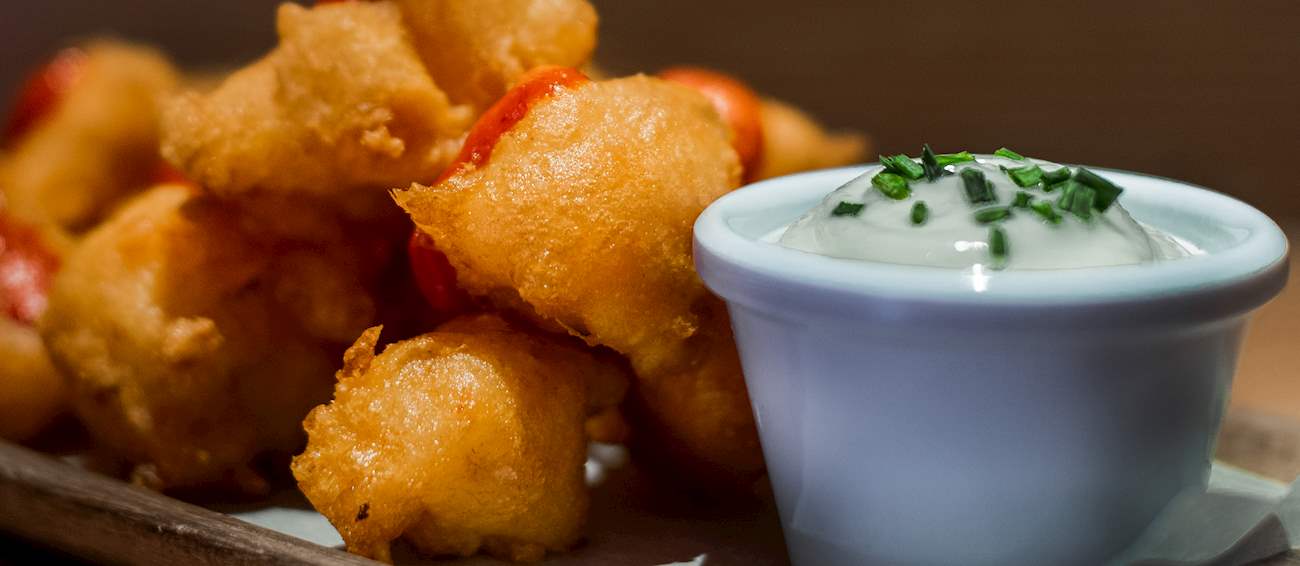MAIN INGREDIENTS
Rosquillas de Santa Clara are Spanish doughnuts traditionally prepared for the feast of San Isidor. They consist of a round-shaped, anise-flavored dough that is generously covered in a powdered sugar glaze. The dough is wrapped into a circle, leaving a hole in the middle.
Rosquillas de Santa Clara are baked in the oven, and when chilled, they are coated in a thick glaze made with sugar and whipped egg whites. These doughnuts are traditionally associated with Madrid, and they are a staple on the feast of San Isidor, the city's patron saint.
OTHER VARIATIONS OF Rosquillas
MOST ICONIC Rosquillas de Santa Clara
View moreSoldaditos de Pavía is a traditional dish that's a staple of Madrid's tapa bars, but it's also often found in Andalusia. The dish consists of strips of battered and deep-fried cod that are served with a strip of roasted red pepper wrapped around them.
Before the frying, the cod is typically marinated in a combination of pimentón and lemon juice. The name of the dish means soldiers of Pavía, referring to the fact that the dish resembles the orange-red uniforms worn by the Hussars of Pavía regiment.
OTHER VARIATIONS OF Tapas
Flores de hojaldre is a specialty of the Spanish city of Alcalá de Henares, consisting of puff pastry (hojaldre) that has been rolled into beautiful shapes of flowers or roses. It is the unique shape of the pastry that has given it its name, which translates to flowers of puff pastry.
At its simplest, flores de hojaldre are distinguished by a light, airy, and flaky texture, and they are usually served dusted with powdered sugar and accompanied by a cup of coffee on the side. Although it's most commonly made in the sweet version, this traditional Spanish pastry can also be savory, depending on the ingredients used for its preparation.
Callos a la Madrileña or Madrid-style tripe is a Spanish dish that consists of tripe, ham, chorizo, and morcilla (blood sausage) cooked in a broth with onions, tomato sauce, garlic, and paprika. Bay leaves, parsley, and saffron are added for extra flavor, while optional ingredients include breadcrumbs, white vinegar, and garbanzo beans.
The dish is cooked slowly at medium to low heat until the broth develops a thick consistency. This typical Madrid dish is believed to date back to the 19th century. Before the 19th century, the dish was served in taverns, but then a luxury restaurant Lhardy included it in its menu and it became widely popular.
One of the most emblematic dishes of Madrilenian cuisine known as cocido madrileño is a hearty meat and chickpea stew whose origins can be traced back to the medieval-era Castilla La Mancha. Some food historians claim that this one-pot meal evolved from a peasant dish called olla podrida Manchega, but wasn't named cocido madrileño until the 17th century.
However, most sources agree that the famed dish has its roots in the Sephardic stew called adafina–a Shabbat kosher meal based on chickpeas, vegetables, and either hard-boiled eggs or meat such as lamb, veal, beef, or chicken. With the arrival of the Inquisition, feared of prosecution by the Catholic priests who roamed the streets of Madrid at the time–in search of both Jewish and Muslim cookery–the converted Spanish Jews called Marranos started incorporating pork into their adafinas to prove themselves as Christians.
OTHER VARIATIONS OF Cocido
MOST ICONIC Cocido madrileño
View moreTasteAtlas food rankings are based on the ratings of the TasteAtlas audience, with a series of mechanisms that recognize real users and that ignore bot, nationalist or local patriotic ratings, and give additional value to the ratings of users that the system recognizes as knowledgeable. TasteAtlas Rankings should not be seen as the final global conclusion about food. Their purpose is to promote excellent local foods, instill pride in traditional dishes, and arouse curiosity about dishes you haven’t tried.









